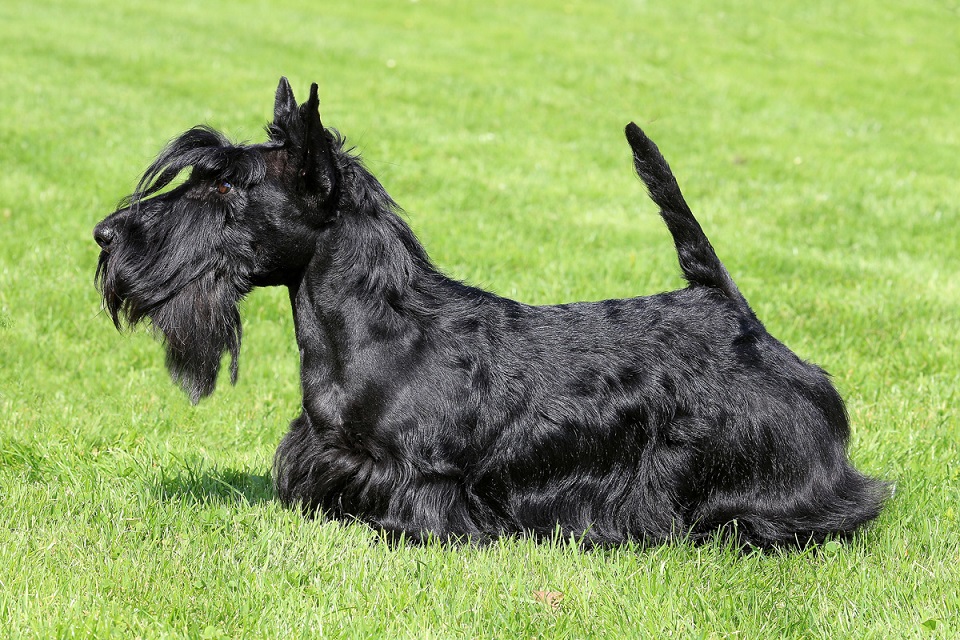
Scottish Terrier

Navigate through the tabs
Navigate through the tabs below to view the breed's info of your interest.
The breed's info is divided in four sections; namely:
the breed's history ,
the breed's main stats ,
the dog's potential health issues
and finally, how the breed scored in 26 different categories.
All the above information should give you a respectively good overview for the dog of your interest.
Dog Breed's Main Info
The Breed's History:
Despite being an old breed, the Scottish Terrier's history is somewhat obscure and undocumented. The Scottie's origin is believed to date back to a dog that was described by Pliny the Elder in 55 B.C. When the Romans invaded Britain, he wrote, "They found, much to their surprise, small dogs that would follow their quarry to the ground". The Romans called the dogs terrarii, which means "workers of the earth" and is derived from terra, the Latin word for earth. The Scottish Terrier was a hunter and still hunts by instinct today.
The Old Scotch Terrier is believed to be one of the oldest breeds in Scotland and the foundation dog for all of today's terrier breeds. The breed is extinct today but was described as a stable worker with strength, courage, and stamina, who could breach his quarry's rocky dens. The breed was a black or sandy-colored dog that was low in stature, strong, with long hair and small, half-prick ears.
If we fast-forward from the first few centuries to 1436, we find a description, in Don Leslie's book A History of Scotland, of a small dog similar in form to the Scottish Terrier. By the early 1800s, many writers wrote of two separate terrier breeds in Britain, the Scottish Terrier (distinguished by its rough hair) and the English Terrier (identified by its smooth hair).
Somewhat earlier, in the seventeenth century, James I of England sent several dogs to France as a present to the French monarch. Those dogs are believed to have been foundation dogs for the modern Scottish Terrier. The king's love of the breed helped to increase its popularity, which rose over the next three centuries.
During the 1800s, Scotland had many terriers. By the end of the century, the dogs had been separated into two different groups, the Dandie Dinmont Terriers and the Skye Terriers (although the latter was a fairly generic name given to all terriers that came from the Isle of Skye). The Scottish Terrier was grouped under the Skye Terriers and shown under that class in the show ring until the 1870s.
At that time, the standard for the Scottish Terrier was written and, by the end of the nineteenth century, the Skye Terriers had been divided into the four different breeds we know today: the Scottish Terrier, Skye Terrier, West Highland White Terrier, and the Cairn Terrier.
Country of Origin:
Scotland
Breed Group:
Terrier
Height:
10 inch. to 11 inch. (25,4 to 27,94 cm)
Weight:
18 to 22 pounds (8,16 to 9,98 Kg)
Life Span:
11 to 13 years
Potential Health Issues:
Von Willebrand's Disease,
Scottie Cramp,
Craniomandibular Osteopathy,
Patellar Luxation
Adaptability
Apartment Living:
First Time Owners:
Sensitivity:
Being Alone:
Cold Weather:
Hot Weather:
Friendliness
Affection With Family:
With Kids:
With Dogs:
With Strangers:
Health and Grooming
Shedding:
Drooling:
Easy To Groom:
Overall Health:
Weight Gain Potential:
Size:
Training
Easiness:
Intelligence:
Mouthiness:
Prey Drive:
Barking or Howling:
Wanderlust:
Need For Exercise
Energy Level:
Intensity:
Exercise Needs:
Playfulness:
Our Mobile Application
Check out Our Mobile Application "Dog Breeds Central"
